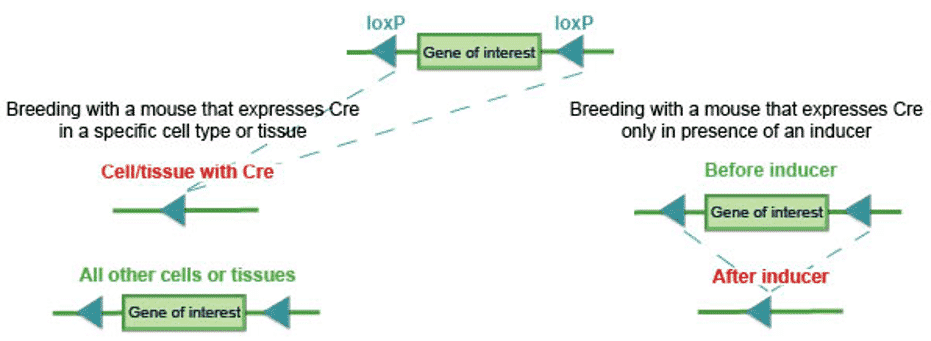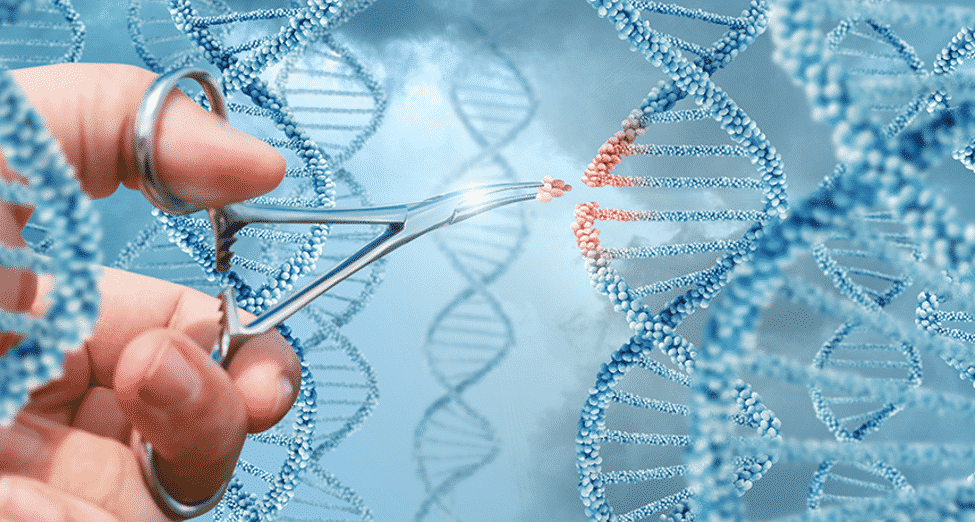What is a conditional knockout (cKO) mouse? Although many researchers are familiar with the term, it is important to understand there are different types of cKO models – all of which have advantages over conventional knockout (KO) strategies. Essentially, the conditional knockout mouse is a sub-category of mouse modeling that can be defined as an animal model wherein genes of interest can be inactivated in a specific cell type of different tissues or at a certain time point.
As knockout strategies prompt either absolute non-articulation or functional loss in proteins, conditional knockout (cKO) models achieve the same in a tissue-specific or inducible manner – the rest of the tissues and cells exhibit unmodified gene expression. The conditional knockout (cKO) mouse strategy can successfully overcome the limits of constitutive knockout (KO) mouse models – such as embryonic lethality, modified animal physiology, compensation mechanisms, and more – to study mechanisms of disease.

What is a Conditional Knockout Mouse?
In simple words, a knockout (KO) mouse is a laboratory mouse in which researchers can inactivate or ‘knockout’ the existing gene by disrupting it or replacing it with an artificial piece of DNA. Compared with constitutively expressed gene mutations (i.e., knockout), conditional models provide greater temporal and regional control of gene expression – often serving as a more accurate model for studying human diseases. There are two types of conditional knockout (cKO) models:
1. Tissue-specific:
Tissue-specific knockout is when a gene of interest is inactivated in a certain tissue in a specific cell type, keeping other cell types and tissues unmodified and gene expression functional.
2. Inducible:
Inducible knockout can temporarily suppress the gene of interest at a given time point in the fetal, postnatal, or adult animal.
The rapidly growing incidence of chronic disorders and the emerging need for prompt and effective therapeutic drugs have massively and positively impacted the global market of mice modeling. Researchers use cKO mouse models to bypass limitations of constitutive knockout strategies and study the mechanisms of human disease.
How Does a Conditional Knockout Mouse Model Work?
There are several methods to obtain a conditional knockout mouse model. However, the Cre-LoxP system has quickly become the most widely adopted and best-suited process to gain the desired results. For this conditional mutagenesis, a targeted gene is selected and modified with the combination of two loxP sites that commonly enable excision of the ‘floxed’ or flanked gene segment with Cre-mediated recombination.

After that, the conditional mutant mouse is achieved by crossing the flanked strain with a Cre-transgenic line. During this whole procedure, the targeted gene becomes inactivated within the expression domain of Cre. At the end of the process, a mouse is obtained with the silenced gene in specific tissues, which is then used for experiments, such as to evaluate potential therapeutic drugs.
Why are Conditional Knockout Mouse Models Needed?
The emergence of a conditional knockout mouse model has overcome many difficulties often encountered when using traditional global knockout models, such as neonatal or embryonic lethality. Nevertheless, the conditional knockout mouse model has various benefits, including:
1. Novelty in Solutions for Drugs
Inarguably, the conditional knockout mouse model offers a novel solution to many of the challenges faced by constitutive knockout modeling. The conditional strategy of gene editing has massively helped scientists and medical experts in the research and development of new drugs for the treatment of various diseases. Currently, the conditional model of the mouse is extensively used in the diverse medical field of immunology & oncology – known as immuno-oncology. Moreover, the increased demand for personalized medicines has further added to the value and importance of this genetically modified mice model.
2. Biological and Genetic Research
When it comes to genetics and biological research, the conditional knockout mouse model plays a vital role since the strategy facilitates developmental studies of genes – experts may decide how and when a specific gene is inactivated or deleted. Genes can be responsible for multiple or unique functions during an individual life span. Thus, this model strategy allows the study of genes in relation to various process requirements. For example, a gene might be necessary for growing and developing an organism before birth. Later, the same gene might maintain functions that impact an individual’s susceptibility to diseases.
Let us discuss another practical example of a conditional knockout mouse model concerning biological research. Cancer has been thoroughly studied with conditional knockout (cKO) mouse models because of the implication of somatic mutations in cancer development and progression. Some types of cancer have been found to be curable with a conditional knockout mouse model; breast cancer is a demonstrable example.
3. The Flexibility of the Process
Conditional knockout mouse model development commonly involves the Cre-LoxP system, which has significant benefits, especially in its flexibility. Unlike the other standard knockout strategies, many options are associated with the Cre-LoxP system that enable generation of multiple research models. The process can be conveniently used to generate constitutive knockout mice lines using the breeding with flanked targeted mouse line and the line that expresses Cre-ubiquitously. If the targeted gene results are limited through other types of knockouts, there are still chances to have results with the conditional knockout mouse model.
4. Investigation: The Role of a Specific Gene
The conditional knockout mice also allow experts and scientists to investigate the role of a specific gene at the required stage of development. For this purpose, an inducible Cre mouse line is bred with the flanked target mouse line. Similarly, the Cre-expressing mouse can be easily crossed with diverse flanked mouse lines to study or investigate a gene to understand tissue-specific behavior.

Final Words
The conditional knockout strategy is getting more considerations today. Organizations and academic establishments associated with investigating and forming new mouse models are likewise ready to utilize fresher and more developed techniques, such as CRISPR and Cre-Lox. Subsequently, these conditional mouse model frameworks assist with fostering a more prominent assortment of derivative mouse lines to study gene function in biology and disease.
Cyagen is a leading service provider of custom designed mouse and rat models, including conditional knockout mice. Cyagen offers fully customized and flexible options for embryonic stem cell manipulation, breeding, microinjection, and others. If you are running an educational institute, hospital, or a part of medical research that require a conditional knockout mouse model, you may contact them for quality services with a unique genotype guarantee. Cyagen can provide numerous knockout approaches to create a customized cell line models, incorporating large fragment knockout, frameshift mutation, and gene knockout.
